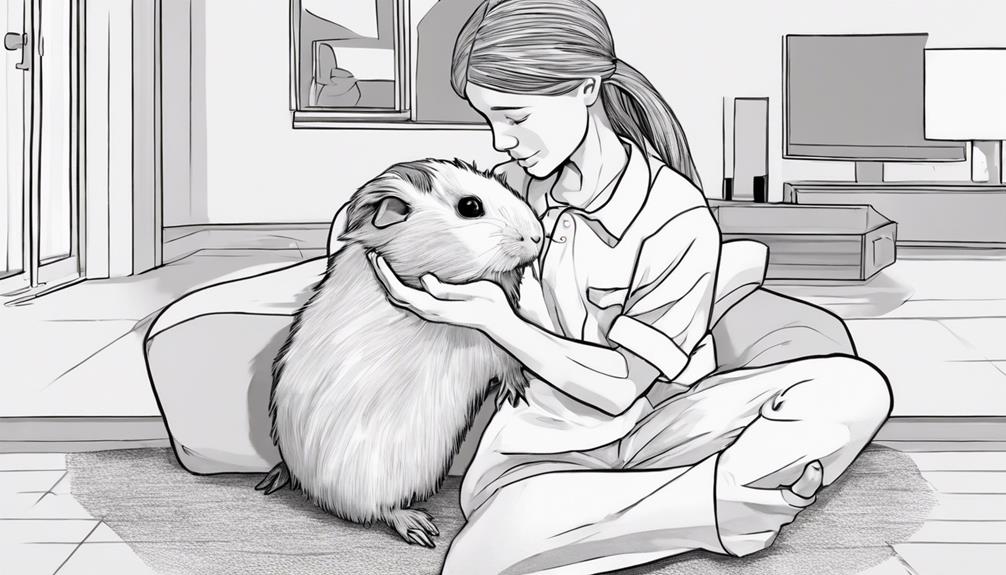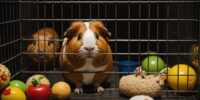What to Do for a Choking Guinea Pig: Emergency Response

When a guinea pig is choking, quick action is essential. If your pet is showing signs of distress such as gasping, pawing at its mouth, or making wheezing sounds, it may be choking on something. Here are key strategies to help save your guinea pig's life in an emergency choking situation:
- Remain calm and act quickly.
- Check your guinea pig's mouth for any visible blockages. If you see something, try to gently remove it with your fingers or tweezers. Be careful not to push the object further down the throat.
- If the blockage is not easily accessible or you cannot remove it, perform the Heimlich maneuver for small animals. Hold your guinea pig with its back against your chest, make a fist with your hand, and place it just below the rib cage. Give a quick but gentle thrust upward to help dislodge the object.
- If the Heimlich maneuver is unsuccessful, seek immediate veterinary care. Time is crucial in these situations, and professional help may be needed to save your guinea pig's life.
Remember, prevention is always the best approach. Keep small objects that could be choking hazards out of your guinea pig's reach, and monitor their environment to ensure their safety.
Key Takeaways
- Stay calm and act quickly to help a choking guinea pig.
- Check for blockages and perform the Heimlich maneuver if needed.
- Monitor breathing and seek immediate veterinary care if necessary.
- Prevent choking hazards and ensure a safe environment for your guinea pig.
Recognizing the Signs
When a guinea pig is choking, it may exhibit clear signs of distress that require immediate attention. Recognizing symptoms is important in ensuring a quick and effective response to help the little pet. Signs of distress in a choking guinea pig may include pawing at the mouth, difficulty breathing, wheezing, gasping for air, or making choking sounds. These behaviors can be distressing to witness, but it's essential to stay calm and focused to help the guinea pig effectively.
Identifying distress in a guinea pig is the first step towards taking emergency action. If a guinea pig shows signs of choking, immediate response is necessary. Emergency steps include carefully examining the guinea pig's mouth to see if there's any visible blockage that can be gently removed. If the blockage isn't visible or can't be easily removed, seeking veterinary assistance promptly is important to ensure the guinea pig's well-being. Remember, acting swiftly and decisively can make a significant difference in saving a choking guinea pig's life.
Stay Calm and Act Quickly
Upon noticing distress in a choking guinea pig, it's essential to maintain a calm demeanor and act swiftly to guarantee the pet's safety. Staying vital and acting quickly are critical in this emergency response situation. Here are three essential steps to help guide you through this challenging moment:
- Take a Deep Breath: Before taking any action, pause for a moment to collect yourself. Deep breaths can help you stay focused and composed during this stressful situation.
- Assess the Situation: Quickly but carefully evaluate the guinea pig's condition. Identify if the pet is choking and in need of immediate assistance to clear its airways.
- Prepare Your Response: While staying calm, prepare yourself to intervene promptly. Having a plan in mind will help you act decisively and effectively to aid the choking guinea pig.
Performing the Heimlich Maneuver

To assist a choking guinea pig effectively, gently but firmly grasp the pet and perform the Heimlich Maneuver following these steps. The Heimlich Maneuver can be a life-saving technique when a guinea pig is choking. Remember to prioritize pet safety and act with urgency in this emergency response situation. Here is a simple guide on how to perform the Heimlich Maneuver on a guinea pig:
| Step | Instructions | Notes |
|---|---|---|
| 1. Assess the Situation | Check if the guinea pig is truly choking. | Stay calm and act swiftly. |
| 2. Hold the Guinea Pig | Gently but firmly hold the guinea pig. | Be careful not to squeeze too hard. |
| 3. Perform the Maneuver | Position your hands below the rib cage and press inwards. | Use gentle yet effective force. |
Checking the Airway
When a guinea pig is choking, promptly checking the airway is important for their safety.
Safely clearing blockages and swiftly evaluating the airway can make a significant difference in the outcome.
Remember to act with confidence and follow the steps carefully to help your guinea pig quickly.
Clearing Blockages Safely
Checking the airway of a choking guinea pig is essential for ensuring their safety and well-being in an emergency situation. Here are some steps to safely clear blockages:
- Gently restrain the guinea pig: Hold them securely to prevent sudden movements.
- Open the mouth: Carefully open their mouth to check for any visible blockages.
- Use a small tool or your fingers: If you can see the blockage, try to gently remove it with a pair of tweezers or your fingers. Be cautious not to push the object further down the throat.
Swift Airway Assessment
After making sure the guinea pig is gently restrained and the mouth is opened to check for blockages, swiftly assess the airway for any obstructions. Airway evaluation is important in determining the appropriate treatment for a choking guinea pig.
Look for any visible objects or food particles that may be causing the obstruction. If you can see the object and it's easily reachable, carefully try to remove it using tweezers or your fingers. However, avoid pushing the object further into the airway.
Administering First Aid

In a choking emergency involving a guinea pig, prompt and proper first aid can be important in saving the animal's life. When administering first aid to a choking guinea pig, it's critical to stay calm and act swiftly. Here are some essential steps to follow:
- Assess the Situation: Quickly but gently pick up the guinea pig and check its mouth for any visible obstructions. Be cautious not to push the blockage further down the throat.
- Perform Modified Heimlich Maneuver: Support the guinea pig securely and deliver five sharp blows between its shoulder blades using the heel of your hand. Check if the object is dislodged after each blow.
- Monitor Breathing: After removing the obstruction, monitor the guinea pig closely. Make sure it's breathing normally and doesn't show any signs of distress.
Seeking Veterinary Assistance
Wondering when it's best to involve a veterinary professional in a choking emergency involving your guinea pig? When a guinea pig is choking, seeking immediate care from an emergency vet is important. If your guinea pig is experiencing severe respiratory distress, persistent coughing, or is unable to breathe, it's time to contact a veterinary professional promptly.
Emergency vets are equipped with the necessary tools and expertise to handle critical situations like choking emergencies in guinea pigs. They can quickly assess the situation, provide appropriate treatment, and guarantee the well-being of your pet. Even if the choking episode seems to have resolved itself, it's still advisable to consult with a vet to rule out any underlying issues that may have caused the choking.
Providing Post-Emergency Care

After a guinea pig has experienced a choking episode, it's important to monitor its essential signs closely. Providing comfort and reassurance to the pet can help alleviate stress and aid in the recovery process.
Remember to observe the guinea pig's behavior and appetite carefully during this post-emergency period.
Monitoring Vital Signs
Once the choking emergency has been addressed, it's essential to monitor the guinea pig's vital signs closely to guarantee its continued well-being and recovery. Tracking symptoms and monitoring progress are critical steps in ensuring the guinea pig's health post-emergency.
Here are three vital signs to keep a close eye on:
- Breathing Rate: Watch for any signs of labored breathing or wheezing.
- Heart Rate: Monitor the guinea pig's heart rate to make sure it stays within a healthy range.
- Activity Level: Observe the guinea pig's activity levels to make sure they're engaging in normal behaviors.
Comfort and Reassurance
Monitoring essential signs has been crucial in ensuring the guinea pig's well-being post-emergency; now, shifting to comfort and reassurance is important for their continued recovery. Calming techniques such as speaking softly, gentle petting, and creating a quiet environment can help soothe the guinea pig. Reassurance methods like offering their favorite treats or toys can also provide comfort.
Comforting gestures such as holding them gently or providing a warm, cozy spot in their enclosure can aid in their emotional well-being. Remember, guinea pigs are sensitive animals, so using soothing strategies like soft music or a familiar scent can further help in their recovery process. By incorporating these calming and comforting approaches, you can assist the guinea pig in feeling safe and secure after a traumatic experience.
Preventing Choking Incidents
To prevent choking incidents in guinea pigs, owners should carefully select appropriate food sizes and textures to guarantee safe ingestion. Guinea pigs are delicate animals, and their small throats can easily become obstructed if given food that's too large or too hard. To make sure the safety of your furry friend, consider the following tips:
- Choking Hazards: Avoid giving guinea pigs foods that have small seeds, pits, or hard shells that can pose a choking hazard. Opt for softer fruits and vegetables that are cut into small, manageable pieces.
- Supervision Tips: Always supervise your guinea pig while they're eating to quickly address any choking incidents. Stay nearby during feeding times to provide immediate assistance if needed.
- Food Preparation: Cut fruits and vegetables into bite-sized pieces to reduce the risk of choking. Additionally, make sure hay is fresh and not too long to prevent entanglement or choking.
Frequently Asked Questions
Can Guinea Pigs Choke on Any Type of Food, or Are There Specific Items That Are More Likely to Cause Choking?
Food safety for guinea pigs is important. While they can choke on various foods, items like nuts, seeds, and hard vegetables pose higher choking hazards. Preventing access to these items guarantees the safety of these beloved pets.
Are There Any Long-Term Effects or Complications From a Choking Incident in a Guinea Pig?
Long-term effects of a choking incident in a guinea pig can include respiratory issues, esophageal damage, or even death. Prevention methods and training techniques can help avoid such emergencies. Recovery may require medical intervention for proper healing.
How Often Should I Check My Guinea Pig's Cage and Toys for Potential Choking Hazards?
Regularly checking your guinea pig's cage and toys for potential choking hazards is important. By maintaining cage cleanliness and inspecting toys, preventive measures can be taken to eliminate hazards. This simple routine guarantees a safe environment for your pet.
Is There a Specific Age or Breed of Guinea Pig That Is More Prone to Choking Incidents?
Age and breed can influence a guinea pig's likelihood of choking incidents. However, proper prevention and care are key for all. Regularly checking for hazards, regardless of age or breed, helps guarantee a safe environment for every guinea pig.
Are There Any Warning Signs or Behaviors That May Indicate a Guinea Pig Is at a Higher Risk of Choking?
Recognizing potential choking risks in guinea pigs involves observing behaviors like eating too quickly or swallowing whole pieces of food. Preventive measures such as providing appropriately sized food and monitoring mealtime can reduce the chances of choking incidents.











